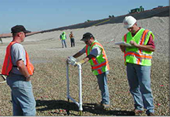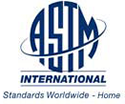This page presents a round-up of updates to ASTM International Committees D18 on Soil and Rock and D35 on Geosynthetics.
 12 March 2013 – ASTM Committee D35 on Geosynthetics has announced the approval of a new standard: D7852 – Standard Practice for Use of an Electrically Conductive Geotextile for Leak Location Surveys. Developed by Committee D35.10 (Subcommittee on Geomembranes), the scope aims for the standard to be “applicable to all types of geoelectric surveys when there is otherwise not a conductive layer under the geomembrane.”
12 March 2013 – ASTM Committee D35 on Geosynthetics has announced the approval of a new standard: D7852 – Standard Practice for Use of an Electrically Conductive Geotextile for Leak Location Surveys. Developed by Committee D35.10 (Subcommittee on Geomembranes), the scope aims for the standard to be “applicable to all types of geoelectric surveys when there is otherwise not a conductive layer under the geomembrane.”
8 February 2013 – Following the late January meetings of ASTM Committees D35 on Geosynthetics and D18 on Soil and Rock, the following standards and work item updates have been announced:
 D4716 – Standard Test Method for Determining the (In-plane) Flow Rate per Unit Width and Hydraulic Transmissivity of a Geosynthetic Using a Constant Head. This standard has been reapproved by D35.
D4716 – Standard Test Method for Determining the (In-plane) Flow Rate per Unit Width and Hydraulic Transmissivity of a Geosynthetic Using a Constant Head. This standard has been reapproved by D35.- D5240/D5240M – Standard Test Method for Evaluation of Durability of Rock for Erosion Control Using Sodium Sulfate or Magnesium Sulfate. This standard has been reapproved by D18.
- D6706 – Standard Test Method for Measuring Geosynthetic Pullout Resistance in Soil has been reapproved by D35.
- D7008 – Standard Specification for Geosynthetic Alternate Daily Covers has been reapproved by D35.
- D7179 – Standard Test Method for Determining Geonet Breaking Force has been reapproved by D35.
- WK40750 – Test Method for Standard Test Method for Determination of Sediment Retention Devices (SRDs) Capability of Removing Suspended Sediment from Sediment-Laden Water for the Purpose of Dewatering. This work item comes from D18.
- WK40774 – Standard Test Methods for Specific Gravity of Soil Solids by Water Pycnometer is a work item revision to existing standard D854-10 from D18.
21 January 2013 – ARTICLE: ASTM D35 Workshop Signals More Accurate AOS/PSD Test and Equipment Coming for Geotextiles
- Geotextiles have historically been characterized by AOS, or “Apparent Opening Size.” This has been measured in accordance with ASTM D 4751, Standard Test Method for Determining Apparent Opening Size of a Geotextile, and many specifications (such as AASHTO M288) and agencies require AOS to be reported. The current AOS testing is not nearly as accurate as it could be, however. And it is expensive. New equipment is making it possible to perform a more accurate characterization test with an existing standard, ASTM D 6767, Standard Test Method for Pore Size Characteristics of Geotextiles by Capillary Flow Test. Read more.
- RELATED READING: Technical Note on Pore Size Distribution in Geotextiles (PDF from TenCate Geosynthetics)











